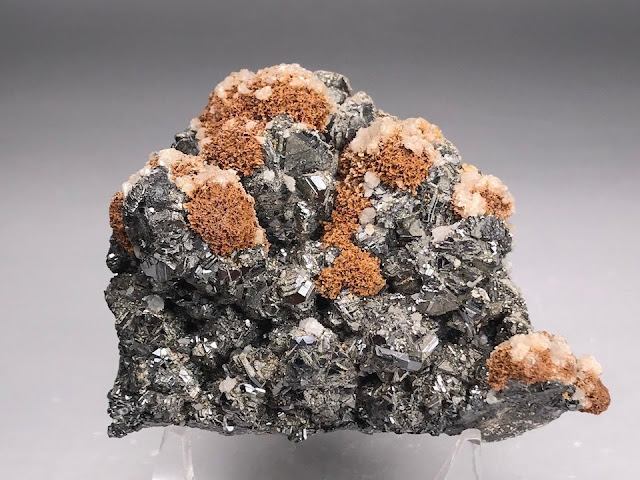秩父の閃亜鉛鉱 Sphalerite from Chichibu
埼玉県秩父市中津川 秩父鉱山 大黒鉱床
Daikoku Deposit in Chichibu Mine, Nakatsugawa, Chichibu City, Saitama, Japan
幅 width 80 mm / 重さ weight 338 g
鉄を多く含んだ黒光りする閃亜鉛鉱の細かい結晶がたくさん積み重なる。見る角度をゆっくり変えていくと、たくさんある結晶面のどれかがランダムに光って、まさに「閃」亜鉛鉱の名に負うキラキラした標本である。白い部分は方解石(CaCO3)、茶色いモコモコは鉄を含んだ炭酸塩の集合で、おそらくアンケル石(Ca(Fe2+,Mg)(CO3)2)か菱鉄鉱(FeCO3)あたりだろう。前者は苦灰石(CaMg(CO3)2)中のマグネシウム(の一部)が鉄に置き換わったもの。他に硫砒鉄鉱の小さな菱餅形の結晶も散りばめられている。
このような硫化鉱物と炭酸塩鉱物との共生は、石灰岩層とマグマとの相互作用で生じるスカルン型の鉱床ではふつうである。とくに大黒鉱床では、通常のスカルン化作用のあと、熱水が石灰岩中に貫入して、脈状・チムニー状の金属鉱床をつくった。有名な糸金や車骨鉱などはそこで産した(くわしくは先日の埼玉・自然の博物館の特別展の図録を参照のこと)。
Many black sphalerite crystals pile up. Sphalerite is in Japanese Sen-Aen-Ko, which means "flashing zinc ore". This is true because this specimen shows random flashing from many crystal faces, when slowly moving a point of view. White crystals are calcite (CaCO3) and brown lumps are probably siderite or ankerite (Ca(Fe2+,Mg)(CO3)2), which is a mineral similar to dolomite (CaMg(CO3)2) but a part of magnesium is replaced with iron. Small rhombic arsenopyrite is also seen. Paragenesis of sulfide and carbonate minerals is common in a skarn deposit like Chichibu. In Daikoku deposit, a hydrothermal process creates veins and chimney-shape deposits after ordinary skarn mineralization. Gold string and bournonite were found in this Daikoku deposit.

